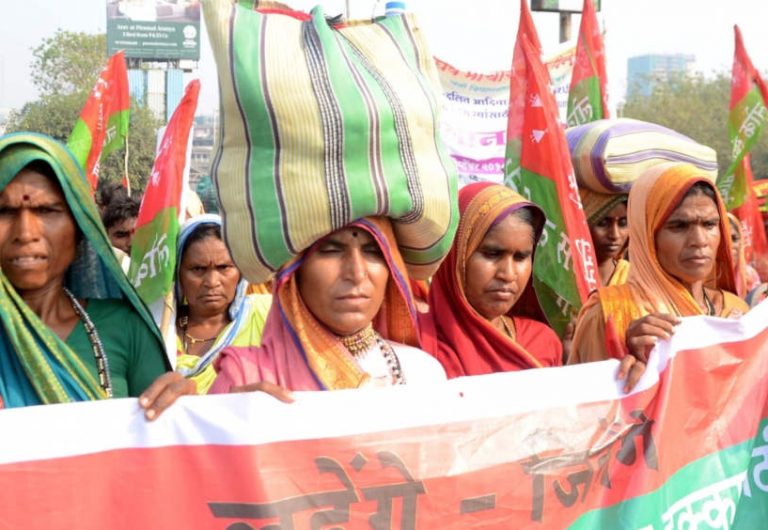Agriculture has got an unprecedented 144% rise in allocation in the interim budget announced by the Bharatiya Janata Party (BJP) government–from Rs 57,600 crore in the 2018-19 budget estimates to Rs 1,40,764 crore in the interim budget

Image Courtesy: IANS Mumbai: Farmers participate in a protest march.
This took the share of the agriculture ministry in the total union budget to 5.2%, a benchmark succeeding governments will be compelled to match for political reasons. For context, the share has been around 2.3%-2.4% since 2014-15, when the BJP came to power.
However, this unprecedented hike in allocation will be inadequate to fight the ongoing agricultural crisis that has led to widespread farm agitations in India. Our analysis of the budget allocation for the sector shows that the amount provisioned for various agricultural schemes, such as the critical irrigation mission, is inadequate. The new income security scheme is short-sighted and inadequate, providing eligible farmers just Rs 500 per month or Rs 3.5 per person per day (considering a household size of five)–not enough to buy a cup of tea, as has been pointed out. It also offers less effective coverage than the Odisha and Telangana income support schemes whose success inspired it.
Not enough to compensate for long years of neglect
In an era of record harvests, prices of agricultural produce have crashed, unpaid agricultural loans have grown, and 600 million Indians who depend on farming struggle to get by, as IndiaSpend reported on November 30, 2018.
The root cause of the agricultural crisis is the perennial neglect of farmers and the deficient policies implemented over the last two decades. Farmers have been demanding the expansion of public provisioning and definitive steps towards the proper implementation of programmes such as Rashtriya Krishi Vikas Yojana, the flagship programme for the agriculture sector, and more flexibility for states to adopt interventions needed to address local concerns.
The continued low priority accorded to public spending on agriculture has resulted in severe gaps in the implementation of schemes with huge shortages of human resources, particularly in agriculture extension services that provide critical information on agricultural practices and schemes to farmers.
Agriculture faced two drought years in succession–2014-15 and 2015-16–when the average growth in the sector was just 0.1% per annum. Data show that over these years the ratio of allocation for this sector to gross domestic product (GDP) remained in the range of 0.3 to 0.4% during 2014-15 and 2018-19. Inadequate public investment also ended up discouraging private investment in agriculture. Between 2014-15 and 2016-17, the private sector investment to GDP ratio came down from 2.2% to 1.8% which led to an overall decline in investment–from 2.6% to 2.1%. This added to the rural crisis and agrarian distress.

Note: *budget estimate, **revised estimate
Irrigation networks will remain underfunded, income support inadequate
The two drought years could have been effectively managed if the government focused on strengthening the irrigation network systems in the country. But little attention or budget was given to creating infrastructure for the agriculture sector.
The Pradhan Mantri Krishi Sinchayee Yojana (prime minister’s irrigation scheme) has always been underfunded, its allocation has seen no rise since its implementation in 2014-15. The budget estimate for 2019-20 for the scheme shows just a Rs 100-crore rise over last year’s budget.
In 2016-17, when the country was yet to recover from drought, the total allocation for the irrigation scheme was reduced from Rs 10,780 crore in 2015-16 to Rs 6,134 crore in 2016-17. In 2017-18, the actual expenditure on the scheme was lower even than the proposed budget, indicating both underfunding and underutilisation of funds.
The agricultural crisis pushed the government to shift its attention towards improving farmers’ income. In the NITI Aayog’s three-year action agenda, the government promised to double farmers’ income by 2022 using 2015-16 as the base year. As 2015-16 was a drought year, farm incomes were lower. This implied that any jump would be easy to manage.
The farming community is still struggling to cover the cost of cultivation leave aside make any income or profits. The BJP government did follow some short-term strategies to raise farmers’ income. One was to increase the minimum support price (MSP) to make farming more remunerative. Raising the MSP to at least 1.5 times of the comprehensive cost of cultivation was one of the recommendations of the National Commission for Farmers led by MS Swaminathan on ways to deal with farm distress. In 2018-19, the MSP for most kharif crops was raised by 23% and for rabi crops by 13%. The annual average rise in MSP for most crops between 2014-15 and 2018-19 was 5-10%. But, this rise was less than 5% in drought years.
The second strategy to address agri distress was to provide a minimum income support to farmers. In the interim budget 2019, the government announced an annual income support of Rs 60,00 to every farmer with less than 2 hectare of land under a scheme called the Pradhan Mantri Kisaan Samman Nidhi (prime minister’s farmers’ fund). This income support is to be provided annually in three installments. There are 120 million farmers deserving of this scheme, as per the government, and the annual estimated cost of supporting them would be around Rs 75,000 crore.
The government proposed to implement this scheme retrospectively from December 2018. For 2018-19, Rs 20,000 crore is proposed and this can only cater to 100 million farmers. This means a transfer of Rs 2,000 per farmer for four months or Rs 500 a month.
(Acharya is the research coordinator at the Centre for Budget and Governance Accountability.)
We welcome feedback. Please write to respond@indiaspend.org. We reserve the right to edit responses for language and grammar.
Courtesy: India Spend
